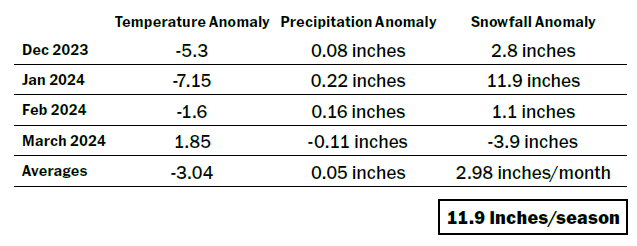Heavy clothing and a good snowblower will be useful items during the winter of 2023-24. Most of the Northeastern section of the U.S. will experience below-seasonal temperatures and above-normal snowfall.
During the last several winters, there were La Nina conditions in the oceans off the coast of South America. Generally, the storm path with a La Nina scenario has storms moving across the northern tier of the U.S. and then up the St. Lawrence River Valley. The center of these storms was then passing to our west.
This is not conducive for causing snowstorms. Actually, in advance of each storm, warm air is pushed into our area, along with some rain. As the storm moves northeastward up the St. Lawrence River Valley, a cold front passes, the precipitation ends and cold air plunges into our area. Bottom line: no snow.
This winter is going to be different. We are dealing with an El Nino winter and it looks like it will be a strong El Nino. Storms will enter the West Coast. Some will move north into western Canada. We don’t have to worry about them. Our concerns are the storms that dive into the Gulf of Mexico. Here they gather a great deal of moisture and warmth. These storms begin to move northeastward and redevelop along the southeast coast of the U.S. It is here they strengthen rapidly and move northward.
We call these storms nor’easters. If cold air is present when the storm arrives locally, we get slammed with strong winds, extreme cold and heavy snow.
What are the chances? Over the past 73 years, between 1950 and 2023, we’ve had 33 major snowstorms along the East Coast, or one every 2.2 years, on average. Of those storms, 28 occurred with either an El Nino or neutral phase of Enso (El Nino – Southern Oscillation). Only five have occurred with La Nina. Major East Coast snowstorms are more likely during an El Nino or neutral winter.
Other factors called “teleconnections” are important. One is called the Pacific Decadal Oscillation (PDO). This can be negative or positive. When the PDO is negative, more often than not, another teleconnection, the North Atlantic Oscillation (NAO), is negative. This is important because a negative NAO has been found to cause a blocking situation, resulting in cold and snowy winters in the Northeast. Both the PDO and the NAO are expected to be negative this winter.
Also, I have found that when El Nino extends from the South American coast westward past 180 degrees longitude (the international date line), it is called an “El Nino West situation.” Snowstorms and cold weather are prevalent during those years.


